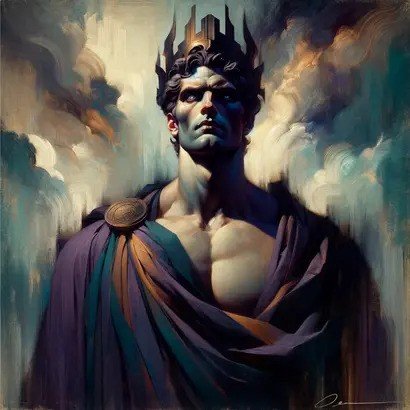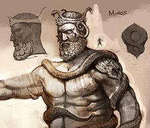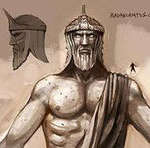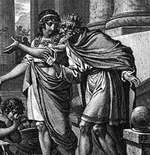
The Underworld
Hidden deep within the bowels of the earth and ruled by the god Hades and his wife Persephone, the Underworld was the kingdom of the dead in Greek mythology, the sunless place where the souls of those who died went after death. Watered by the streams of five rivers (Styx, Acheron, Cocytus, Phlegethon, and Lethe), the Underworld was divided into at least four regions: Tartarus (reserved for the worst transgressors), the Elysian Fields (where only the most excellent of men dwelled), the Fields of Mourning (for those who were hurt by love), and the Asphodel Meadows (for the souls of the majority of ordinary people).
The Geography of the Underworld
Much of what we know about how the Ancient Greeks and Romans imagined the Underworld we know from Homer’s “Odyssey” and Virgil’s “Aeneid.” However, even these two visions are somewhat conflicting, so, sometimes, we have to resort to assumptions to reconstruct the Greek Underworld in its entirety.
Entrances
According to Homer, the Underworld was located beyond the earth-encircling river of Ocean, at the far western end of the world. However, some other authors inform us that there were quite a few places within the known world one could use as portals to enter the kingdom of the dead:
• A cavern near the ancient town of Tenarus. Situated at the tip of the middle promontory of Peloponnese (known back then as Cape Tanaerum, and called Cape Matapan today), the cave exists to this very day; it was through this cave that Heracles dragged Cerberus out of Hades and Orpheus tried to bring Eurydice back to the world of the living.
• The bottomless Alcyonian Lake at Lerna. Guarded by the fearsome Hydra, the Alcyonian Lake was supposedly used by Dionysus to enter the Underworld and search for his mother Semele; some even say that Hades abducted Persephone in its very vicinity.
• The volcanic Lake Avernus. Located in southern Italy near the city of Naples, Avernus was sometimes used as a synonym for the Underworld in Roman times; it is through a cave found near this lake that Aeneas descends to the Underworld in Virgil’s “Aeneid.”
Rivers
By all accounts, the Underworld was a chill and shadowy place, watered by the streams of five infernal rivers:
• The Styx. Circling the Underworld seven times, Styx was the river of hatred and unbreakable oaths; the gods are often depicted as taking vows by its waters.
• The Acheron. The river of sorrow and pain, black and deep.
• The Cocytus. The river of lamentation and wailing.
• The Phlegethon. The river of fire, possibly leading to the depths of Tartarus.
• The Lethe. The river of oblivion and forgetfulness, out of which the dead souls are obliged to drink so that they can forget their earthly lives in preparation for a possible reincarnation.
Underworld's Structure
Initially, it seems that the Ancient Greeks believed that all souls, regardless of how exemplary or dishonorable their earthly lives might have been, ended up in the same place after death. And for most of them, the Underworld couldn’t have been a particularly pleasant place: it was rather like living through the same dismal nightmare over and over again, battling for breath in a world inhabited by shadows, barren of hope, ill-lit and desolate. And this is how sometimes the Underworld is described by ancient authors: nothing more than a joyless realm where the dead were supposed to slowly fade into nothingness or, as we learn from Plato’s Myth of Er, prepare themselves for a reincarnation back to earth.
However, this all changed at some stage, and according to later writers, the Underworld was divided into at least four different regions:
Tartarus
In “The Iliad” Zeus claims that Tartarus is “as far beneath Hades as heaven is above earth” and that it “is the deepest gulf beneath the earth, the gates whereof are of iron and the threshold of bronze.” Originally the dungeon of the rebels against the divine order (the Cyclopes and the Hecatoncheires during the reign of Cronus, and the Titans once Zeus came to power), Tartarus eventually ended up housing the worst of perpetrators, destined here to eternally endure punishments fitting their earthly crimes. Some of Tartarus’ most famous inhabitants were Sisyphus, Tantalus, Ixion, and Tityos.
The Fields of Mourning
As we read in the “Aeneid,” the Fields of Mourning are reserved for the souls of those “whom ruthless love did waste away;” here, they “wander in paths unseen, or in the gloom of dark myrtle grove: not even in death have they forgot their griefs of long ago.” Curiously enough, almost all of the fields’ inhabitants mentioned by Virgil are women: Phaedra, Procris, Pasiphae, Evadne, Laodamia, and, of course, Dido.
The Asphodel Meadows
We don’t know that much about the Asphodel Meadows – it could have been a realm of utter neutrality – but we do know that it is there that Odysseus meets the shade of Achilles in Homer’s “Odyssey.” “Grieve not at all that thou art dead, Achilles,” says Odysseus unto him, pointing out to the great hero that he is blessed to rule mightily among the dead of this region. “If I could choose,” replies Achilles memorably, “I would rather be a paid servant in a poor man's house and be above ground than king of kings among the dead.”
The Elysian Fields
Strangely enough, other authors place Achilles in a wholly different realm of the Underworld called Elysium (or the Isles of the Blessed – if the two are one and the same), where only the most exceptional mortals were privileged with a life free of toils and pains. Ruled by either Rhadamanthus or Cronus (or both), Elysium was a land of eternal sunlight and rosy meadows, inhabited by the likes of Cadmus, Peleus, and Menelaus.
The Journey of a Soul After Death
Hermes
Upon death, a soul was led by Hermes near the entrance of the Underworld, where a ferry awaited to carry it across either the Acheron or the Styx.
Charon
This ferry was rowed by Charon, the infernal boatman tasked with taking the souls of the dead to the Underworld proper. Only those who could pay the fare with coins (obols) placed on their eyes or under their tongue when buried, were granted passage; the rest remained trapped between two worlds. (Aeneas was only able to enter the Underworld once his guide, the Cumaean Sybil showed Charon a golden bough, Aeneas’ gift for Persephone.)
Cerberus
After the boat ride, the souls entered through the gates of the Underworld; the gates were guarded by the multiheaded dog Cerberus, who allowed everyone to enter, but none to leave.
The Judges
The souls then appeared before a panel of three judges, Rhadamanthus, Minos, and Aeacus, who passed sentence based on the mortals’ deeds during their previous life. Most souls seem to have ended up in the neutral zone, the Asphodel Meadows; for better or for worse, others were singled out for special treatment.
The Underworld Sources
A whole book of the “Odyssey” – the 11th – is dedicated to Odysseus’ descent into the Underworld; analogously, Virgil devotes the 6th book of the “Aeneid” to Aeneas’ similar journey.
See Also: Hades, Minos, Rhadamanthus, Aeacus, Aeneas, Charon, Cerberus, Tartarus
The Underworld Video
Link/Cite The Underworld Page
Written by: The Editors of GreekMythology.com. GreekMythology.com editors write, review and revise subject areas in which they have extensive knowledge based on their working experience or advanced studies.
For MLA style citation use: GreekMythology.com, The Editors of Website. "The Underworld". GreekMythology.com Website, 08 Apr. 2021, https://www.greekmythology.com/Myths/Places/The_Underworld/the_underworld.html. Accessed 26 April 2024.






